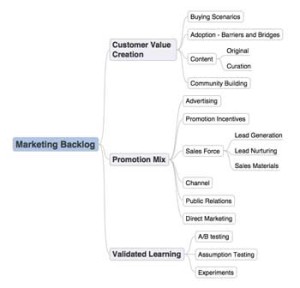 In helping a number of teams adopt Agile Marketing and observing many others, I’ve come to conclude that there are at least three stages or approaches to Agile Marketing. They’re not necessarily sequential. I have listed them in what I consider an order of difficulty, from most straightforward to most difficult, and in order of the potential value to the organization when they’re done well.
In helping a number of teams adopt Agile Marketing and observing many others, I’ve come to conclude that there are at least three stages or approaches to Agile Marketing. They’re not necessarily sequential. I have listed them in what I consider an order of difficulty, from most straightforward to most difficult, and in order of the potential value to the organization when they’re done well.
Agile Marketing as Workflow Management
Scrum and Kanban were developed and applied by software developers and manufacturing organizations to manage workflow – the production of software and automobiles, respectively. These two workflow management techniques can be applied to certain areas of marketing in a rather straightforward fashion: managing content generation, for example, using Scrum or managing Social Media using Kanban.
I’ve seen a number of organizations adopt this stage of Agile Marketing successfully. Northern Arizona University’s Extended Campuses group increased their productivity by 400 percent. David Lesué and his team over at Workfront have adopted Agile not only to improve the productivity of their team, but also to improve retention.
This stage of Agile Marketing is also the stage that is closest to the way that most software development teams use Agile. Many tools exist to manage workflow using Scrum and Kanban, and it feels like the most straightforward stage to adopt and see results quickly.
Agile Marketing for Adaptive and Iterative Campaigns
One of the central tenants of the Agile Marketing Manifesto is that we value “Adaptive and iterative campaigns over Big-Bang campaigns“. One of the most influential presentations at the SprintZero event, where we wrote the Agile Marketing Manifesto, was given by Rohn Jay Miller. He presented a slide, nicked from a British agency, Made by Many, that resonated with many of us in the room.

Today this approach is referred to as “growth hacking” or “high-tempo testing”. I don’t particularly care what you call it, but this second stage of Agile Marketing involves a change in mindset. It requires marketers to forego complex planning and polishing of campaigns in favor of speed and learning by iteration. It also requires a little of the scientific mindset: proposing a hypothesis, and finding value whether your hypothesis is proven or disproven.
For some marketers, this shift in mindset is difficult, but it is critical that they make this shift if marketing organizations are going to adapt to the pace of change we are experiencing today. I believe it is also critical to learning. When marketing teams invest in the big idea, big launch, big budget campaign style, the temptation to measure the campaign’s success by vanity metrics rather than actionable metrics is too great. The iterative, emergent development process sees “failures” not as failures but as opportunities to learn which lead us to the best answers and the best approaches to meeting customer needs.
There are fewer tools to manage this process (although some are starting to emerge) and I’ve seen only seen a few teams adopt this approach, but there are a few. Twitter adopted this approach very successfully, as described here and here. In addition to Made by Many, a number of agencies that I’ve worked with have also adopted this approach.
The Agile Marketing Organization
How do you create an organization that is responsive to change, able to turn on a dime, able to respond within hours to both opportunities and threats? I believe that you need to more than simply adopt stages one and two, as described above. For this stage of Agile Marketing, you must hire the right people and put in place the right processes to adapt to change. At the very least, you need to do three things well:
- Hire for agility – this isn’t obvious, and there are many marketers who’ve been successful in the past who aren’t very agile. I’ve written about how to hire for marketing agility, as has Paul Roetzer over at Hubspot and Scott Brinker at Chief Marketing Technologist. I encourage marketing leaders to develop their own methodology for hiring for agility.
- Set up quarterly disruption and opportunity meetings – when people accuse me, as an agile marketer, for not having long range plans, I beg to disagree. It’s true that I’m a huge critic of the year long planning exercises practiced by both large companies and by VC-led boards of many startup companies. These plans are outdated soon after they’re presented, and they are a huge waste of time and money. Instead, set up quarterly meetings to assess the forces in the industry that threaten to either disrupt your business or provide you with opportunities. There will be carry over from quarter to quarter, and certain trends will take years to develop, but the planning needs to be refreshed at least every three months. You can try to predict the future in broad terms years out, but trying to build budgets or make exact predictions more than 3 months in advance is a fool’s errand in my book. Whether you use SWOT, Porter’s Five Forces or Clayton Christensen’s disruptive innovation theories (my favorite, see why here) or you just discuss what could happen, it’s important to get senior leaders together at least once a quarter, and to make this part of someone’s job to monitor in between meetings. By the way, Roland Smart has written a new book on Agile Marketing, and he is very articulate about how to organize these meetings. You should pre-order the book.
- Set up an emergency response and newsjacking team – I bet Volkswagen’s facilities managers, at least in California, had an earthquake preparedness plan, and in Germany they planned and prepared for fires and other potential disasters. But did they have a marketing team that was prepared to respond to the real disaster that might take the company down? From their tepid response to the Dieselgate scandal, I’m guessing that they didn’t have this team in place. Does Starbucks have a team in place to deal with Donald Trump’s suggestion that conservative Christian’s boycott Starbucks because they use the phrase Happy Holidays rather than Merry Christmas? In addition to having a team that responds to these kind of potentially brand damaging events, agile marketing organizations should have a team in place (perhaps the same team) to take advantage of newsjacking opportunities.
There is much more to say about how to set up an agile marketing organization, but this post is already seriously long. If you’d like to learn more, you might also check out Jascha Kaykas-Wolff’s book Growing up Fast. It’s a quick read, doesn’t take itself too seriously, and has some great nuggets about how to organize and manage an agile marketing team, something that Jascha has been doing longer than anyone.
What do you think? Do these 3 stages of agile marketing resonate with your experience? Are there other stages that I haven’t thought about? I’d love to hear from you in the comments.





Thanks for sharing this post Jim!
When I think of stages of Agile Marketing I tend to think of stages in an adoption cycle. In my experience it starts with a pilot project. Pilots demonstrate where Agile adds value and fuel broader adoption. Then there comes a point at which the Agile marketing team has to connect their implementation with the Agile implementations in other groups. Or, the marketing team drives the adoption of the approach into the groups they work with.
This speaks to a broader organizational adoption cycle. In many respects I see Agile expanding across departments inside companies: typically from development to product management, marketing, and even finance (Bjarte Bogsnes has written a great book on this last area). From my perspective the benefits of Agile get really good once marketing and product development have Agile teams that are well integrated with each other.
Roland,
I struggled with the word “stages”. Perhaps its not the right word. I thought of phases or approaches. In any case, you’re right – organizations do go through an adoption cycle, starting with pilot projects and progressing through different functions and departments within the organization. Everyone’s experience is different, and while I see some rough trends, I was trying to explain a different issue – how the term agile marketing can apply to three very different things: workflow management, iterative learning, and creating an agile organization.
I’m looking forward to getting my hands on the finished book!
Pingback: Issue 38 - Agilean Weekly
Great article Jim. I’m just learning the ins-and-outs of Agile as applied to marketing and your blog posts make great reading.
As someone trained in “traditional” marketing (ala MBA), I think one of the reasons it’s difficult to change mindsets is that traditional marketing is linear. As you pointed out, you tend to move from big idea -> big launch -> big budget, etc. This gives the project a very nice beginning, middle, and end. Reaching “the end” is what everyone works toward, what KPI’s measure, and what is celebrated when reached. The idea of marketing where you never reach “the end” takes some getting used to – as well as the redefinition of working terms, KPI’s, benchmarks, etc.
The main goal in Agile Marketing is no longer “the end,” or the completion of a specific project, be it a brochure or catalog, for example. Therefore, the success of an Agile Marketing Department shouldn’t be measured in terms of the number of collateral pieces produced. Success should be measured more in terms of: “What did we learn?” “How well did we lead the market?” “How fast did we react to the competition?” “How have we improved?” etc.
Am I on the right track? If so, how do you measure THOSE types of variables? As a Manager, how do you budget for THAT (or justify existing budgets)? In short, how do you measure success when the old metrics (pieces of collateral, number of trade shows attended, etc) are no longer appropriate or adequate?
Hiram
http://www.hiramperez.com
Pingback: 3 Stages of Agile Marketing - AgileMarketing.net - Agile Marketing Blog - Home of Marketing Agility Podcast
Pingback: 5 Steps to Successfully Implement Agile Marketing Processes - Docurated
Pingback: 50 Top Agile Marketing Resources: Examples, Training, More